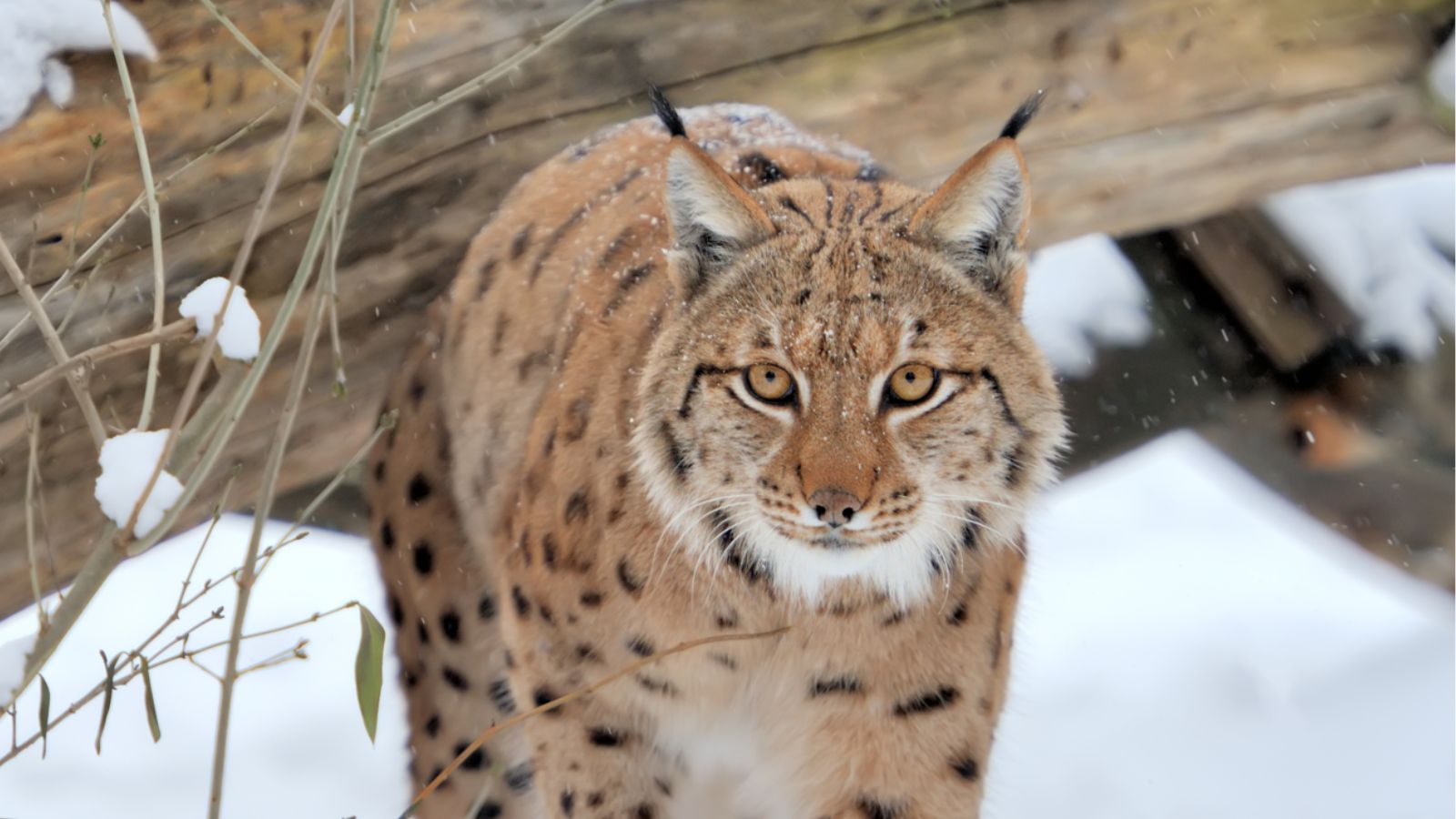Bobcats can be found across most of North America and are a close relative of the larger Canadian lynx. They’re known for their distinctive short tails and tufted ears and can be found in suburban areas. Here are 19 things you never knew about bobcats.
Short Tails

Bobcats can be easily identified by their short, “bobbed” tails. The Felidae Conservation Fund explains that because they “primarily hunt on the ground and in fields for rodents and hares, they have not evolved with a long tail” and that it helps them catch prey in open fields and prevent larger carnivores from noticing them.
Reproduction and Lifespan

Bobcat breeding season occurs in the spring, but some bobcats will breed again later in the year. Females give birth to a litter of one to six kittens after around 50 days of gestation. Kittens stay with their mothers during their first year, becoming increasingly independent before they leave.
Ears

Bobcats are known for their distinctive ear tufts, which have white spots near the tips. The back of their ears also features two white spots, which scientists believe help female bobcats’ kittens follow their mother in dim light.
Conservation Status

The IUCN has listed bobcats as a ‘Least Concern’ species since 2002 because of their wide distribution and large population. Despite extensive hunting targeting bobcats for fur and sport, their populations remain mostly stable.
Territorial Behaviors and Home Range

Male bobcats have territories that can span 30 square miles, while females have a much smaller range of five square miles. They mark their territory with urine and/or feces, along with claw marks.
Interactions with Other Wildlife

Adult bobcats have relatively few predators. They are rarely killed by several larger predators, including cougars and gray wolves, and alligators and golden eagles have been observed preying on them. Kittens have more predators, including eagles, foxes, bears, great horned owls, and even adult male bobcats.
Habitat Range and Adaptability

Bobcats are incredibly adaptable and can be found in much of North America. Smithsonian’s National Zoo & Conservation Biology Institute explains they can be found in habitats “including boreal coniferous and mixed forests in the north, bottomland hardwood forests and coastal swamps in the southeast, and desert and scrublands in the southwest.”
Seasonal Behaviors

Bobcats are mostly active during twilight in the spring and summer, but during the winter months, they have been observed to become more active during the day. This diurnal behavior is thought to be a response to the activity of their prey, which is more active during the day in the cold winter weather.
Vocalizations and Communication

Bobcats are usually silent and communicate through visual signals, scent, and some vocalizations, but will primarily be vocal when they perceive a threat or defend their territories. When they feel threatened, they will hiss, growl, and produce spitting noises.
Native Americans and Bobcats

Many Native American tribes traditionally respected the bobcats for their adaptability, courage, stealth, and strength. In other tribes, they have played more negative roles in traditional stories as a greedy, selfish animal that disregards social rules.
Tracking and Research Techniques

Scientists employ a range of methods to track and study bobcat behavior, including GPS collaring and trail cameras. These research techniques have shed light on their movement patterns and their communities.
Impact of Climate Change on Bobcats

Warmer temperatures due to climate change in recent years have led bobcat populations to thrive in northern states in America and Canada because of decreased snowfall. Over the past decade, they have been spotted further north in Canada than ever before.
Bobcats in Popular Culture

Bobcats have left their mark in popular culture in America. From 2002 to 2014, the Charlotte Hornets used to be known as the Bobcats, and the Ohio Bobcats of the NCAA Division I have Rufus the Bobcat as their mascot.
Diet and Hunting Techniques

Bobtails have a carnivorous diet. Britannica explains that they feed on smaller animals, including “rodents, rabbits, hares, and some birds.” When hunting, bobcats quietly climb tall trees and maneuver around rocky terrain, pounce on their prey, and can kill them with one bite.
Bobcat Myths and Misconceptions

Some Americans worry about bobcats being dangerous to humans, but they will only attack them if they feel their kittens are threatened. They can kill house cats and smaller dogs, but it’s not a common occurrence.
The Economic Impact of Bobcats

Bobcats were a popular choice for trapping for the fur trade during the 19th century, but the practice is much less common today. Bobcat watching and photography are more popular today, with photographers camping for hours to get the perfect picture.
Tracks

Bobcat tracks are identifiable by their four toes without claw marks due to their retractable claws. Tracks range in size from around 1 to 3 inches, with the average being around 1.75 inches. Their larger size makes them distinguishable from house cats.
Size

Adult bobcats range from 19 to 49 inches long from head to tail, with an average length of 32.6 inches. They stand around 12 to 24 inches at the shoulders and have an average weight of 21 lb. The largest bobcat ever accurately measured weighed 49 lb., but some roadkill specimens have weighed as much as 60 lb.
Subspecies

Bobcats have two recognized and 11 unrecognized subspecies. Lynx rufus is found in the eastern and midwestern United States, while the subspecies Lynx rufus fasciatus lives west of the Great Plains. The unrecognized subspecies are found in smaller areas, like California’s Mojave Desert.
Read More: 17 Things That Are Sadly Disappearing From Everyday Life

Life in modern times seems to evolve at an unprecedented pace. Certain things we couldn’t live without a few years ago are rapidly becoming redundant. Let’s take a peek at 17 such victims of modernization and why they’re slowly but surely disappearing.
17 Things That Are Sadly Disappearing From Everyday Life
15 Ways To Tell If Someone Is Not a Good Person

While it’s important to avoid quick judgments, certain behaviors can be strong indicators of a person’s character. Here are 15 ways to discern if someone might be a bad influence or possess harmful traits.
15 Ways To Tell If Someone Is Not a Good Person
19 Untrue American Stereotypes That Are Widely Believed Internationally

Stereotypes and misconceptions can be misleading and frustrating, especially when they pertain to nationalities. Let’s explore and debunk some common myths about America, as shared by internet users.
19 Untrue American Stereotypes That Are Widely Believed Internationally
18 Everyday Items That Have Now Become Too Expensive For the Average American

There are some items that we have to pay for every single day. But for the average American, these mundane things are becoming too expensive. In this article, we will show you 18 of these pricey day-to-day items.
18 Everyday Items That Have Now Become Too Expensive For the Average American
18 Hard Truths to Accept in Life, According to Boomers

The older we become, the more we learn about life, and with that come the truths that we need to accept. Boomers have had their fair share of truths as they’ve grown through the years. Here are 18 hard truths that every boomer wants us to know.

